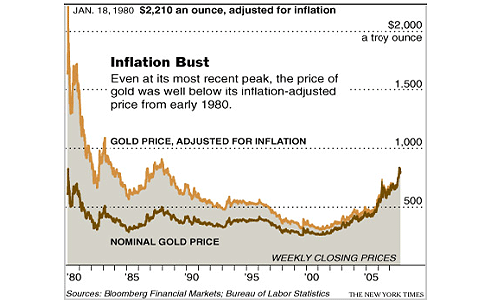| Home | About Us | Resources | Archive | Free Reports | Market Window |
How China Could Push Gold to $1,000 An Ounce This YearBy
Saturday, January 12, 2008
In the most recent issue of the Weber Global Opportunity Report, I sized up the current situation in the gold market. To me the news is contained in the chart below:
Even though in purely nominal terms, gold is around the same $850 "record" level we saw in 1980, in real terms gold is very far below that level. Gold would have to be more than $2,000 per ounce to approximate that 1980 level in today's prices. Further, very few people own any gold at all. Ask yourself about the people you know. Chances are they don't own any. In fact, I know many of you reading this essay don't own any gold or silver. Though gold is now trading at a record high, it is still roughly around January 1980 prices. How many other assets can you say this about? The average home is maybe five to six times what it was 28 years ago. The Dow is about 14 times what it was then. Looked at in this way, gold is still a bargain. Now look at the way the central banks are throwing newly created paper money and credit at every problem that comes up. Put this together, and gold's rise has far, far more to go. I am very impressed by the way gold has stayed above $800. The month of December 2007 was the first month in history where gold closed the month over $800. I think we will see it touch $1,000 in 2008. This would be less than 20% from where it ended last year, at $833.80. After all, gold rose over 31% during 2007 (from $636 to $833.80). If it only had two-thirds of that juice this coming year, we'll see $1,000 gold. Gold's percentage gains since its bull market began in 2001 are laid out below:
This year, China is beginning the country's first-ever trading in gold futures contracts. These are of fairly small size: 1,000 grams, or 32.15 troy ounces per contract. Buyers can put down as little as 7% of the contract, or less than $1,900 per contract at today's prices. Gold production in China has been soaring in recent years. And according to the China Gold Association, 2008 may be the year that China becomes the world's biggest producer, leapfrogging over Australia, South Africa, and current-No. 1 producer the U.S. And last year, China overtook the U.S. to become the second-largest consumer of gold, after India. With gold futures contracts being traded on the Shanghai Futures Exchange in sizes that don't shut out the smaller investors, there could be huge demand on the part of the average Chinese for gold this year. If the stock market falters, or enough smart investors start to diversify out of stocks and into gold, this could have a huge impact on the price. Good investing, Chris Weber Editor's note: With gold hitting new record highs just about every day now, if you don't own any gold, you are missing out on easy money. Right now, Chris has three safe ideas that will get you into today's bull market in gold. Each of them is likely to make you a lot of money this year. Click here for the details.Market NotesA RELIEF RALLY IS ON THE WAY... Seventy five percent of individual investors believe the stock market will be lower in six months time... This may sound like bad news to most investors, but actually, an extreme in bearish sentiment is often a great short-term buying opportunity for speculators... you see, extreme pessimism often precedes rallies in the stock market. The chart of the week compares the S&P 500 index to a sentiment survey released by the American Association of Individual Investors (AAII). As you can see, pessimistic extremes often correspond with good buying opportunities. The average four-week return following these gloomy periods is 2% (much larger than the average four-week return in the market)... And 91% of the time an extreme like was reached, the market rallied. – Ian Davis |
Recent Articles
|


